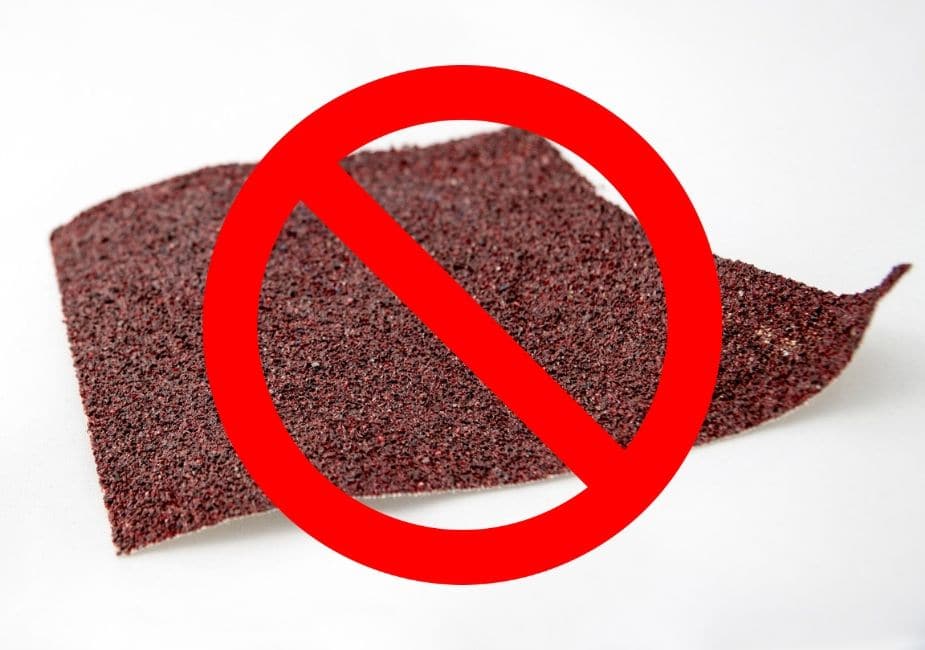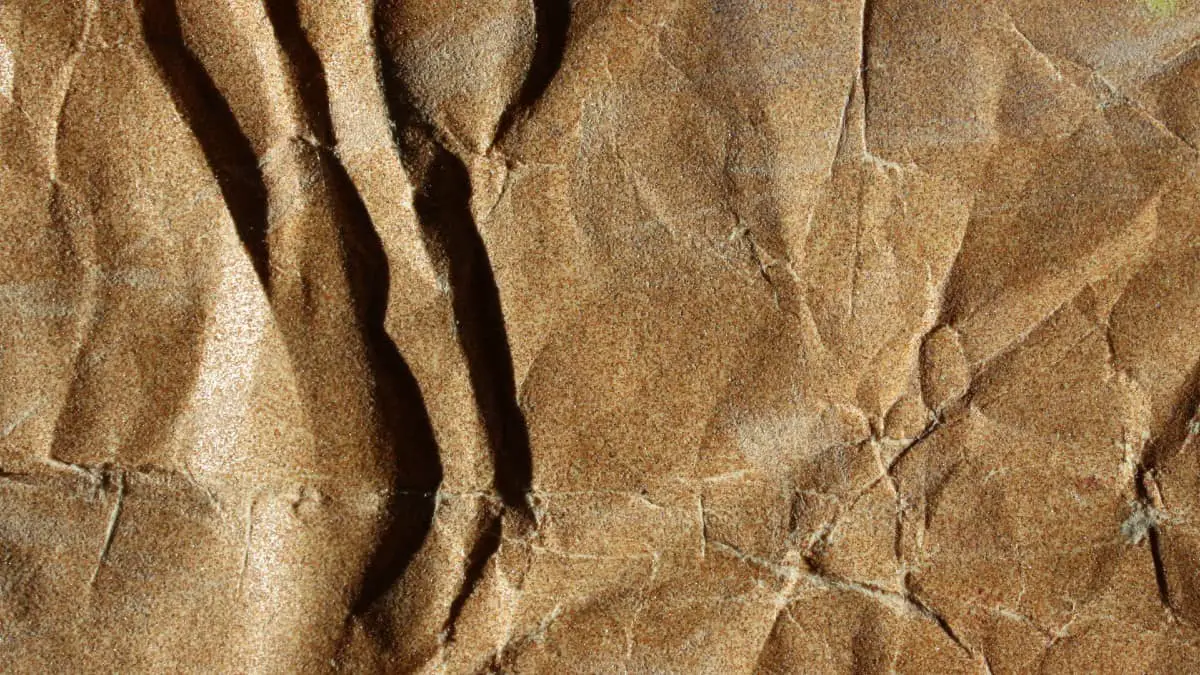How to sand wood without sandpaper? Is this some sort of trick question? I guess not …
Yes, it IS possible to do this. First, you need to use an abrasive material such as sand, pumice, sandstone, or similar. Rub wood with it along the grain in order to smooth the surface and remove imperfections. When you have removed marks, move to a “finer” grade of the abrasive and repeat the process. When you have reached the desired smoothness, you can stop the process.
As with normal sanding, you need to sand “with the grain”. This is to prevent cutting wood fibers and leaving marks on the wood. This is something that really “rubs me the wrong way” (pun intentional).
So, let’s be serious. I’ll go into more detail …
Note: This post may contain affiliate links. If you purchase a product through an affiliate link, I’ll earn a commission, at no cost to you. To find out more, see my full disclosure.
Why Would You Want to Sand Wood Without Sandpaper?
Is there a reason why you would want to sand without sandpaper? After all, standard sandpaper from the hardware store is more convenient and easy to use. A sheet of sandpaper has a defined grit value, so you know exactly how rough the material is.
Also, most electric power sanders use normal sandpaper. These power tools make the chore of sanding easier and quicker. So, it makes sense to use them!

So, why do some people sand without sandpaper? Below are a few of the reasons:
It’s Only Natural
Some people are very “Eco-conscious”. That is, they show great concern for the environment. They don’t waste energy resources by producing materials such as sandpaper. After sandpaper has been used, the abrasive particles are worn and dull. They don’t want to throw out pieces of sandpaper and add to the world’s garbage. I wrote an article about recycled wood here.
When you use an abrasive found in nature, there’s no need to use any energy to produce the sandpaper. Also, there’s no need to transport the sandpaper from factory to hardware store and use energy that way. You don’t need to drive to the store or heat the store. As a result, you dump fewer greenhouse gases into the atmosphere.
No Hardware Store Nearby
We all take it for granted the hardware store is nearby. However, this isn’t always the case. Suppose you live in an “off the grid” location, somewhere in the middle of the woods. You would be far away from all the stores. It’s possible that you could be without electricity, as well.
Without electricity, you would not be able to use timesaving electric sanders, even if you had a supply of sandpaper.
You wouldn’t be able to get to the local shopping mall or Home Depot. However, you could use what was available in the natural environment. You could collect sand and sharp stones such as quartz. Then, you could use a cloth and rub the wood. This would substitute for sandpaper.
Want To Finish What You Started
Pumice is a volcanic rock. The powdered rock is an abrasive. Commonly, one can work with a coarser grade of pumice, or use a finer grade.
Moisten the wood with mineral spirits or some other liquid. Next, sprinkle pumice on top. Then, rub it into the finish with cloth, felt, or a similar material. This makes the finish smooth.
Rottenstone has even smaller grains. First, mix the Rottenstone with mineral spirits or some other liquid, Then, rub it into the wood. This polishes the finish.
Is this really sanding? Well, maybe not…
However, I will consider it to be sanding for the purposes of this article.
Save Money: Sand Wood Without Sandpaper
One thing about sandpaper: Once you use it and the abrasive is dull, it cannot be used again. At this point, you need to throw it away and buy new sandpaper. This always seems to happen at an inconvenient time. So, you have to make another trip to the hardware store, Home Depot, Lowe’s, etc.

You can’t use the other paper you have, because the grit is wrong. That is, it will leave marks on the wood. You need to move from the coarse grit to progressively finer. This means that you will have to stock up on multiple grits.
In addition, you might also want sandpaper for your electric sanders and other power tools. These can include sanding discs, sanding drums, and sanding belts for a belt sander. Often it is possible to tear a standard 9×11 inch sheet of sandpaper into halves or quarters for use in electric sanders. However, we can’t always do this and you may need to purchase special sanding sheets for your tools.
It’s also a shame to use sandpaper once, then throw it away. This is really a wasteful process. Once the abrasive grains are dull, the sandpaper can’t be used. I wrote an article about sanding here.
Sometimes, the sandpaper backing tears. Most electric sanders can’t use sandpaper like that.
It costs a lot of money to keep your shop stocked with all of these items. Wouldn’t it be better to use fine sand or some other natural abrasive?
Substitutes: How To Sand Wood Without Sandpaper
Here is a list of some abrasives. Most of these materials are available in the natural environment. Of course, there are more:
Sand
Use a cloth, felt pad, sanding block, or similar material and rub the wood with sand. Results will be better if the abrasive grains are the same size.
You need to be careful when working with sand. Sand is mostly silicon dioxide (SIO2). When you put these particles in the air (such as in sandblasting), silicon dioxide particles can get into the lungs. This is a real health hazard.
Pumice
Pumice is a porous volcanic rock. You can polish wood by rubbing it with this abrasive. Pumice is available in coarse and fine grits.
First, moisten the wood. This prevents the Pumice from clumping together and gouging out the wood. You then sprinkle some pumice onto the wood and rub with a cloth or similar material. This process makes the wood smoother.
Rottenstone
Rottenstone is very similar to Pumice. However, the particles are even finer. You rub this abrasive into the wood in order to polish it.
Walnut Shells
Crushed Walnut Shells are abrasive. Use this material to polish wood surfaces. Here are some crushed walnut shells:
4 lbs or 1.8 kg Ground Walnut Shell Media 18-40 Grit – Medium Coarse Walnut Shells for Tumbling, Vibratory Or Blasting
These shells have many features:
- Can polish soft and sensitive materials
- 18 – 40 grit
- Environmentally friendly
Corn Cobs
Crushed Corn Cobs are also abrasive. They can polish wood.
Ways To Remove Wood Without Sandpaper
This article is about sanding without sandpaper. In the most abstract sense, we are talking about rubbing an abrasive into the wood. because of this, we will not be considering the following:
- Planing – This refers to a wood plane, power wood jointer, wood surfacer, or similar device.
- Wood Rasp – It is either a hand tool or electric drill accessory. I have written an article about electric drill accessories here.
- Wood File – This is usually a hand tool.
- Wood Carving – This refers to the removal of wood with a knife, chisel, or similar tool.

Tips: How to Sand Wood Without Sandpaper
So, you plan to use non-sandpaper abrasives for your next project. These tips will help you sand wood more quickly, with less effort, and with better results:
Uniformity
Some abrasive grains are larger than other grains. You really want all grains to be the same size. Otherwise, you will leave marks on the wood.
From Coarse to Fine
Start with a coarse grit size. This will take off marks and Imperfections. However, it will scratch the surface of the wood. Continue with a finer grain and remove the scratches left by the rougher grit. Repeat this process until the wood has the desired smoothness. I wrote an article about sanding mistakes here.
Clean Off Old
When you change from one grit size to another, it is important to remove old sawdust, residue, and grains from the wood. You do this to avoid leaving marks caused by the larger grains, and other materials.
You can vacuum the material off, use compressed air, or wipe the wood with mineral spirits. Allow the wood to dry fully before continuing.
Another option is to use a tack cloth to pick up the old material. Tack cloths are used for wood finishing.
Sand With Grain
When you rub the abrasive into the wood you should move with the grain. If you sand across the grain, you will cut wood fibers and leave scratch marks on the surface.
Apply Even Pressure
Rather than push on the wood with the surface of your palm, you might want to use some sort of a sanding block or similar device. This applies even pressure to the wood and helps reduce gouges in the surface.
Also, by using a solid block, you might find that you have a little more “leverage” and that the sanding process is easier.
Avoid Scratching Side
When you sand towards the edge of the wood you need to make sure that you don’t bang into another piece. This is easy to do because the space you have is limited. When you move a short distance along the grain, you can hit the other piece of wood.
If this happens, the abrasive grains can leave scratches on the other pieces of wood. These marks are very hard to remove and can ruin wood finishes.
To avoid this situation, you might need to sand the wood before assembling the project. Another option is to take the project apart, if possible.
How To Sand Wood Without Sandpaper: Conclusion
In this article, we found that it’s possible to sand wood without sandpaper. We define this process as rubbing the wood with an abrasive in order to smooth the surface.
Next, we discuss why someone would actually want to do that when it’s really easy to obtain sandpaper from the local store. We describe some of the benefits of not using sandpaper.
Finally, we give several tips in the “How to Sand Wood Without Sandpaper” section. When you follow these practices, your results should be better, your project should take less time to complete, and the entire process should be more enjoyable.
Don’t forget to follow my boards on Pinterest. Did you enjoy this blog post? If so, please consider sharing.



I read through your blog post here. Could you help me with a question I have please. What is the best type of sander for sanding a deck? My current belt sander just broke on me right in the middle of refinishing my dad’s deck. Eagerly awaiting your reply. :]
Thanks for your interest in the blog. It’s really hard to say. However, the belt sander is probably not the best tool to use for the deck. It might have a tendency to “gouge” the wood unless you keep it moving. Probably, a random orbital sander or orbital sander will work better for you. In any event, best of luck!